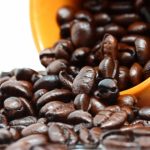
Check out any coffee product at your grocer and you will most likely see ‘Arabica Beans’ or ‘Arabica Coffee’. However there are different types of coffee beans out there. It seems peculiar for a coffee officianado to say this because they are most likely aware there are another three types that can be picked up but we don’t really see them in the grocery aisles that often.
The Arabica coffee bean is very popular and accounts for most of the coffee we find in bags, be they whole beans or ground to a fine powder. The Arabica bean now accounts for somewhere between 60 and 70 per cent of the total amount of coffee produced worldwide The remaining 30 to 40 per cent of other types of coffee bean can be found if you know where to look however and frankly you do not have to look far.
Coffee is seen by some as one of the most successful plants ever because to humans it produces a great beverage and it is one where man has attempted to grow the plant for profit. The Arabica plant is probably the most successful ever from that point view.
The Characteristics Of Coffee Beans
The four main types of coffee beans are:
- Arabica (Coffea arabica),
- Robusta (Coffea caniphora),
- Liberica (Coffea liberica),
- Excelsa (Coffea liberica var. dewevrei).
Coffee comes from three distinct species. The Excelsa variety is a form of Liberica.
Arabica
The most commonly cultivated is Coffea arabica. It’s name tells us that this coffee originated in the Arabian peninsula and was brought to Europe during the Ottoman Empire.
The Arabica coffee bean is still the most important commercially in Europe and North America. It has a relatively sweet, sophisticated flavour which is not as harsh or acidic as Robusta which we discuss later.
The Arabica plants are grown easily and without too much fuss at high altitudes where plenty of rain is needed. Brazil has a large rainforest type climate which is ideally suited to cultivation. It’s also grown in other upland places where the climate is extremely warm and wet like Ethiopia, Colombia, Guatemala and Costa Rica.
All coffee plants are prone to frost but can be grown in slightly cooler regions if given cold protection. We have an Arabica coffee plant that grows in the greenhouse in the UK but it never produces coffee berries because plenty of uniform and consistent light is also a requirement.
The plant is unfortunately easily damaged by coffee rust so growing it without incurring the issues of disease are not straightforward. Rust is often a debilitating disease and is common to many plants although the rust is often produced a fungus specific to that plant. We often discuss onion rust for example and whilst they are not the same species their characteristics are similar and cause irreparable damage to the plant.
Rust damage has caused the price of coffee to rise on many a case when it has taken hold because there are occasions when damage is so severe the harvest is ruined. A number of coffee producers have used other species in the past when rust has damaged the Arabica crop. It’s also the case that coffee drinkers are perfectly happy to pay the price increase because Arabica coffee is of such high quality with its sweeter, less acidic and bitter flavour compared to other varieties.
Robusta
Robusta is the next coffee species to be grown commercially and is popular as a plant and coffee product in the Middle East, Africa and Europe. It has a strong, very full flavoured profile which explains its name. The aroma is exceptional although drinkers in the USA complain it too harsh and strong for their palettes. It is the case though that Robusta drinkers have increased in North America as the café culture has developed in more urban centres.
Robusta coffees have higher caffeine levels than Arabica which makes it popular as a sports coffee product as well as suitable for our palettes where a high caffeine bitterness is needed. Caffeine is well as known as an insect repelling compound so it is one of the reasons why coffee has become so prevalent around the world.
The species Coffea caniphora grows in environments in which Arabica is not suited to nor necessarily thrives in. It grows in more temperate conditions and does not even require the high cloud altitudes needed for Arabica cultivars.
Robusta is often used for cheaper coffee products and for dried and instant types because the flavour is much stronger and the aroma is retained better. It is a filler coffee meaning it can be used to proportion out Arabica for creating dark or well-cooked roasts. In some cases it becomes a filler because it is often a cheaper bean to produce and incorporate into blended coffee products. Don’t be foiled though as the product is often designed to meet exacting consumer requirements for a more fuller and rounder coffee flavour.
Look for single-blend Robusta coffee products because they are only available from bespoke small-scale coffee producers. They are usually found in European groceries and delicatessens. Not that common in North America.
Liberica
This coffee plant is native to central and western Africa. It is commercially grown in the Eastern Pacific including the Philippines, Malaysia and Indonesia.
This is a coffee worth seeking out because it is scarce and generally only available from specific outlets. The beans when roasted produce a flavour which is regarded by experts as one of the best. It has a a more floral aroma than other species.
Liberica was introduced as an alternative coffee for cultivation when rust devastated the Arabica crop in the late 19th Century. The Philippines was the main producer of Arabica coffee but was then devastated by rust. At the time, the country was part of the USA in terms of its protectorate status and became a sole supplier of coffee to this country. When Arabica became largely unavailable the Liberica species was introduced. However, when the country declared independence the outcome was restricted supply and Liberica coffee no longer had the prominence it once had simply because it was unavailable. Liberica coffee is still available but now in only limited quantities.
Excelsa
Excelsa is a variety of Liberica but not as common grown as it could be. The coffee is gown mainly in the South-East of Asia but it is produced as a small percentage of total coffee production.
The flavour is described by consumers as fruitier still with a tart overtone. It shows characteristics of both light and dark coffees but the unique profile is sought by coffee experts who crave a particular distinct note in their coffee.
Types Of Coffee Beans: What Should I Buy
Coffee is meant to be drunk and enjoyed and at various times of the day too. It’s most likely that you would enjoy Arabica type coffee because that is what you have probably grown up with and is the most common flavour around. In the USA it is all likely to be Arabica. Come to Europe and the Middle East and Robusta becomes a more predominating flavour. There are greater options in terms of blends and availability. When we have drunk coffee in Continental Europe such as France and Italy there is often a distinct bitterness provided by the Robusta bean but that should not be off-putting to anyone needing a strong caffeine fix in the morning.
Look out too for individual coffee blends and products from particular countries. The country of origin will often be an indicator of the type of bean being used in the product. It’s also worth checking the variety on the packet too as this will help you understand why a particular blend is sweeter, sharper or just stronger in flavour.
Whatever the case happy coffee drinking.


Leave a Reply